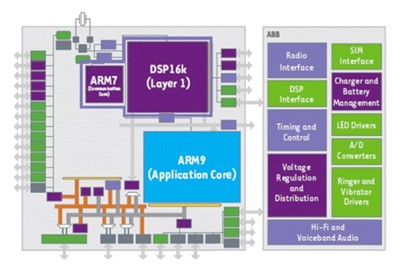High-integration mobile phone chipset supports Linux
Oct 17, 2005 — by LinuxDevices Staff — from the LinuxDevices Archive — 3 viewsAgere Systems is sampling a two-chip mobile phone chipset targeting GPRS/EDGE multimedia phones running Linux and other OSes. The Vision X115 chipset includes an analog baseband chip, along with a tri-core digital baseband chip integrating an ARM9 applications processor, ARM7 communications processor, and Agere “DSP1600” for physical layer/audio processing.
Agere says its highly integrated X115 chipset can reduce handset component counts by up to 100, while shaving 20 percent off of physical footprint and BOM (bill-of-materials) cost. The design targets midrange feature-phones, as well as high-end smartphones. It is designed to work with EDGE/GPRS networks, a transitionary “2.5G” system developed by Motorola to allow mobile carriers to add relatively high-speed Internet access to mobile networks without requiring full infrastructural upgrades.
Agere says the X115 supports streaming QVGA (320×240) video at 24fps — the same framerate used in movie theaters — along with QCIF video, which has a resolution of 144 x 176 and a framerate of 30fps. The chipset can accelerate popular video codecs that include H.263, MPEG-4, and H.264.
Additionally, the X115 features CD-quality playback audio (16-bit, 44.1kHz), in formats including MP3, AAC, aacPlusT, and Enhanced aacPlus. The combination of AAC stereo audio and video playback results in a “theater-quality experience,” the company says.

X115 Block Diagram
(Click image for larger view)
The two-chip X115 chipset comprises an analog baseband chip plus a multicore digital baseband chip. The analog baseband chip handles analog baseband processing, audio mixing and conversion, and system power management functions. The digital baseband chip contains three processor cores — an ARM7TDMI-S communications processor, an ARM926EJ-S applications processor, and Agere's DSP16000 core for physical layer and audio signal processing. The communications processor serves as the system's “master controller,” ensuring reliable communications regardless of running applications, the company says.
Agere says it designed the X115 to support Linux, Windows Mobile 5.0, and Symbian.
Analysis
Mobile phone chipsets are becoming more integrated, driven by more and more stringent power and size requirements. Such technology could result in widespread mobile enablement of a broad class of consumer electronic devices, from portable music players to handheld gaming devices and PDAs.
Recently announced high-integration mobile chipsets include Renesas's mysterious “LSI” (large-scale integration) effort, which began sampling in August, and Motorola's MXC (mobile extreme convergence), which was successfully demonstrated in May. Mobile chipset marketshare leader Texas Instruments (TI), meanwhile, is shipping its OMAP VoX with support for Linux and Nucleus. Philips, Freescale, and others also offer highly integrated mobile chipsets and multi-chip modules.
Compared with the LSI, MXC, and others, the X115 appears to positioned as better supporting complex operating systems, including not only Linux, but also Symbian and Windows Mobile 5.0. A low-cost, high-integration mobile chipset could help mobile marketshare leader Symbian, as well as Microsoft, better compete in the high-volume, mid-market feature-phone market. Linux is well positioned in that segment today, according to Linux mobile stack providers Trolltech and MontaVista.
Availability
The X115 is expected to achieve mass production sometime this quarter, Agere says.
This article was originally published on LinuxDevices.com and has been donated to the open source community by QuinStreet Inc. Please visit LinuxToday.com for up-to-date news and articles about Linux and open source.